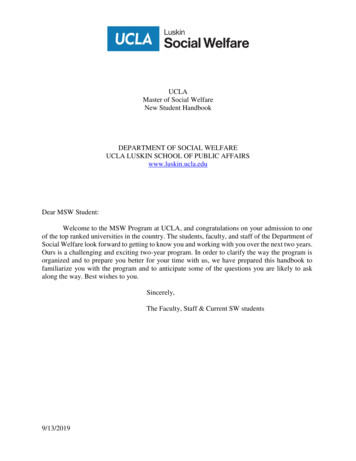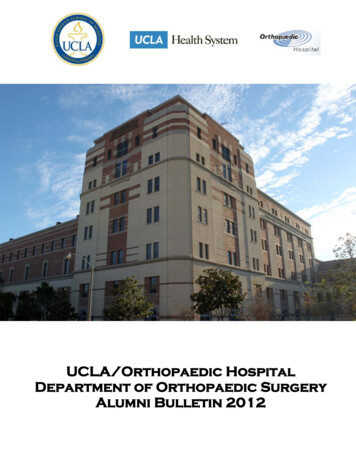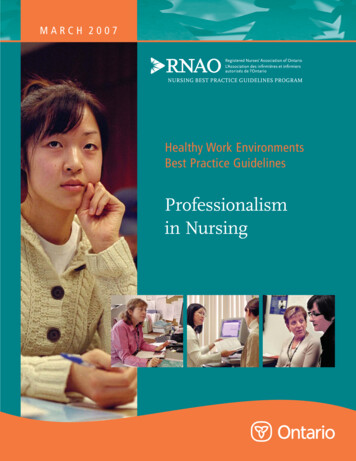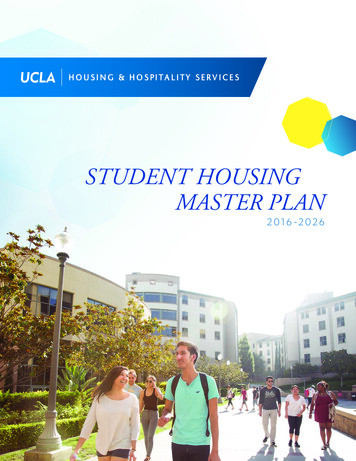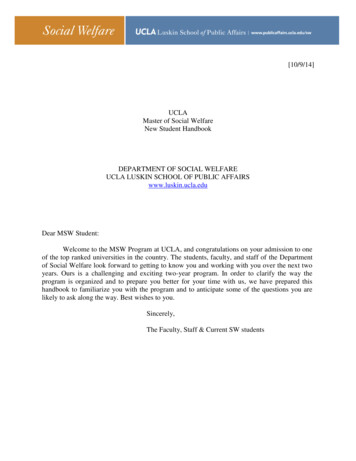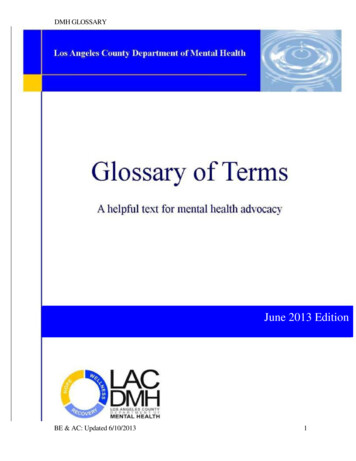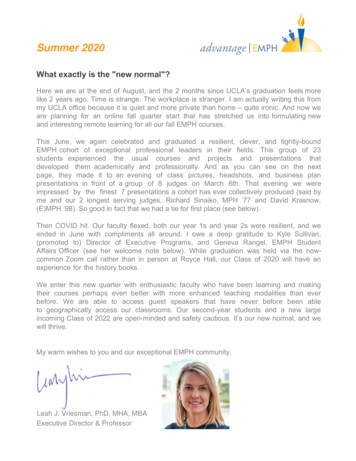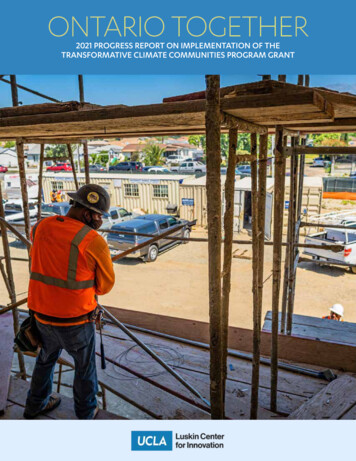
Transcription
ONTARIO TOGETHER2021 PROGRESS REPORT ON IMPLEMENTATION OF THETRANSFORMATIVE CLIMATE COMMUNITIES PROGRAM GRANT
AcknowledgmentsPrepared by the UCLA Luskin Center for InnovationPrincipal Investigator: J.R. DeShazo, Ph.D.Co-Principal Investigator: William Eisenstein, Ph.D.Researchers: Silvia González, Jason Karpman, Bo Liu, Britta McOmber, and Kelly TrumbullEditor: Colleen CallahanPrepared forCalifornia Strategic Growth Council (SGC) (Contract Number: SGC18124)Report PeriodOntario Together award date (January 2018) through the end of month 16 of implementation (June 2020)AcknowledgmentsWe thank SGC for commissioning the UCLA Luskin Center for Innovation to conduct a five-year, third-party evaluation ofTransformative Climate Communities Program (TCC) investments in Ontario. In particular, we thank Louise Bedsworth,Alexandra Gallo, Sandra Lupien, Saharnaz Mirzazad, Gerard Rivero, and Sophie Young for their commitment to our work,and for their attention to our many informational requests.In addition to our state partners at SGC, we’d also like to thank our partners at the California Department of Conservation — namely, Brendan Pipkin, Elizabeth Hessom, and Sydney Mathis — for reviewing the accuracy of TCC backgroundinformation provided in this report.This report would also not have been possible without the support of a team of skilled undergraduate and graduatestudent researchers who helped with data collection, analysis, writing, editing, and document design. Specifically, wewould like to recognize Deanna Cunningham, Emma French, Elena Hernández, Bo Liu, Sharon Sand, and Deja Thomas fortheir work on this document.We owe a great deal of gratitude to Nick Cuccia for his copy editing and design support.We would also like to thank Bruce Mirken, Alvaro Sanchez, and Emi Wang at the Greenlining Institute for their thoughtfulinput on how to structure the content contained in this report.Moreover, a big thank you to all of the Ontario Together project partners for sharing so much primary data with the evaluation team, as well as reviewing the content within this report for accuracy.Finally and importantly, the authors also acknowledge the Gabrielino and Tongva peoples as the traditional land caretakers of Tovaangar (Los Angeles basin, Southern Channel Islands), and recognize that their displacement has enabled theflourishing of UCLA.DisclaimerThe UCLA Luskin Center for Innovation appreciates the contributions of the aforementioned agencies. This report, however, does not necessarily reflect their views nor does it serve as an endorsement of findings. Any errors are those of theauthors.For More Informationwww.innovation.luskin.ucla.eduCover image: Construction of Vista Verde Apartments, a 101-unit affordable housing project located in Ontario and funded by TCC, inApril 2020 (Photo credit: Aero Cine Pros Inc.) May 20, 2021 by the Regents of the University of California, Los Angeles. All rights reserved.2 Ontario Together: 2021 Progress Report on Implementation of the TCC Grant
Table of Contents EXECUTIVE SUMMARY 4Ontario Today 5Ontario Together 5Projects 6Transformative Plans 7Anticipated Benefits 8Cumulative Accomplishments 9Operationalized Transformative Plans 10BACKGROUND 13The Vision Behind TCC 13Evaluating the Impacts of TCC 16Ontario Together: Looking Back and Forward 19PROFILES: TRANSFORMATIVE PLANS 21Community Engagement Plan 22Stories From the Community: Grassroots model empowers residents to serve as local leaders 24Displacement Avoidance Plan 26Workforce Development Plan 28PROFILES: TCC FUNDED PROJECTS 31Active Transportation Projects 31Affordable Housing and Sustainable Communities Project 33Organics Recycling Project 35Rooftop Solar Projects 37Transit Operations Project 39Urban and Community Forestry Project 41PROFILES: LEVERAGED PROJECTS 43Healthy Ontario Initiative 44Stories From the Community: Initiative inspires residents to get well and give back 46Small Business Support Program 48Stories From the Community: Business incubator program provides community and inspiration 50 APPENDICES 52Appendix 1: Supplemental Maps 52Appendix 2: Summary of Methods for Estimating Project Benefits 54Appendix 3: Ontario Together Trustees 55Appendix 4: Ontario Together TCC Census Tracts 56Appendix 5: Ontario Together Control Census Tracts 57Appendix 6: Indicator Data 58Appendix 6.1: Demographics 58Appendix 6.2: Economy 62Appendix 6.3: Energy 64Appendix 6.4: Environment 66Appendix 6.5: Health 67Appendix 6.6: Housing 71Appendix 6.7: Transportation 75Ontario Together: 2021 Progress Report on Implementation of the TCC Grant 3
EXECUTIVE SUMMARYTHE TRANSFORMATIVE CLIMATE COMMUNITIES PROGRAM(TCC) is an innovative, new investment in community-scale climate action, with potentially broad implications. Launched in 2017by the California State Legislature, TCC funds the implementationof neighborhood-level transformative plans that include multiplecoordinated projects to reduce greenhouse gas (GHG) emissions.The program is also designed to provide an array of local economic,environmental, and health benefits to disadvantaged communities,while minimizing the risk of displacement. TCC empowers thecommunities most impacted by pollution to choose their own goals,strategies, and projects to enact transformational change — all withdata-driven milestones and measurable outcomes.OntarioTogetherOntarioJanuary 2018Award AnnouncedMarch 2019June 2024Grant ExecutionThe California Strategic Growth Council (SGC) serves as the lead administrator of TCC. During the first round of the program, and througha competitive process, SGC awarded multimillion-dollar grants to theCity of Fresno ( 66.5 million), the Watts Neighborhood of Los Angeles( 33.25 million), and the City of Ontario ( 33.25 million). During thesecond round, SGC awarded the City of Sacramento ( 23 million) andPacoima, the Northeast San Fernando Valley neighborhood of Los Angeles ( 23 million). And during the third and most recent round, SGCawarded the City of Oakland ( 28.2 million), the City of Riverside ( 9.1million), and the City of Stockton ( 10.8 million).The UCLA Luskin Center for Innovation (LCI) serves as the lead evaluator for all three Round 1 sites, one Round 2 site (Northeast SanFernando Valley), and one Round 3 site (Stockton). LCI researchers areworking with the these communities to document their progress andevaluate the impacts of TCC investments.This progress report is the second in a series of five that will provide anoverview of the key accomplishments and estimated benefits of TCCfunded activities in Ontario, collectively referred to as Ontario Together.1 This specific report documents progress through the end of FY2019-20, which overlaps with about 16 months of program implementation (March 2019 through June 2020) and the first four months ofthe COVID-19 pandemic. Project partners’ responses to the pandemicare highlighted throughout the report.For annual reports that document TCC investments in Fresno and Watts, limate-investments/14 Ontario Together: 2021 Progress Report on Implementation of the TCC GrantGrant CompletionJune 2020Key Accomplishments To Date9913 street trees plantedi ndividuals placed in jobsafter meeting with newworkforce specialist8 ublic workshops aboutpOntario Together projectsand plans7s olar PV systems installedon homes occupied by lowincome households5r esident leaders hired toassist with communityengagement efforts4c onvenings of OntarioTogether Trustees, aresident-inclusive grantgovernance body;2 ew buses powered bynrenewable natural gas putinto service1 eighborhood fair thatnspotlighted OntarioTogether investments
Ontario Together’s community engagement team and fellow fitness instructors at a neighborhood fair in February 2020.Photo credit: City of OntarioOntario TodaySituated in the Inland Valley of Southern California, downtown Ontario sits at the intersection of a busy transportation corridor, an underutilized retail and commercial area,and several residential neighborhoods. The residents ofthis area are predominantly Hispanic. The community facesmany economic and health challenges, including highrates of poverty, housing insecurity, asthma, and obesity.Climate change could exacerbate these challenges. Despite local collaboration to address some of these challenges, the community continues to need more affordablehousing and transit access, training and job opportunities,and safe spaces to walk, bike, and play.Ontario TogetherThe foundation for TCC in Ontario was laid in 2007, whena coalition of community residents, partners, and the Cityof Ontario came together to improve the quality of life intheir city by creating the Healthy Ontario Initiative (HOI).In 2010, Ontario was awarded a Healthy Eating and ActiveLiving (HEAL) Zone grant by Kaiser Permanente to expandHOI community engagement activities. The partnershipsand goals borne out of HOI eventually laid the groundworkfor Ontario’s proposal for grant funding through TCC. Toensure that the city’s proposal reflected the priorities ofthe community, public workshops and meetings were heldto collaboratively select projects that would address healthand economic disparities, food security, housing and transit, active transportation, and other key issues identified bythe community.Engagement efforts resulted in Ontario Together, acommunity-driven plan and initiative to transform a4.86-square mile area of Downtown Ontario through asuite of projects and plans that will reduce greenhouse gas(GHG) emissions while also providing local environmental,health, and economic co-benefits. In early 2018, OntarioTogether was selected by SGC for a TCC grant of 33.25million to bring its vision to fruition. Ontario Together willalso leverage at least 28.9 million in outside funds towardthis vision. Along with Fresno and Watts — two other sitesawarded Round 1 TCC funding — Ontario will serve as oneof the first communities in the country to pilot a community-led, multi-benefit, and place-based climate changemitigation program that specifically targets the needs oflow-income households.Ontario Together: 2021 Progress Report on Implementation of the TCC Grant 5
EXECUTIVE SUMMARY ProjectsOntario Together includes a total of 10 projects, eight ofwhich are funded by TCC dollars and two of which are funded by leveraged dollars. The TCC funded and leveragedprojects work synergistically to achieve the broad goals ofTCC. The TCC funded projects and leveraged projects areconsolidated into eight distinct project types (summarizedbelow), and are mapped in Figure 1 (where applicable):TCC Funded ProjectsActive Transportation — Funds twodistinct projects aimed at improving andexpanding infrastructure for bicyclists andpedestrians, with one project filling in 435feet of missing sidewalk segments through the community, and the other project adding 5 miles of bikes lanesand 3 miles of sidewalks along a major corridor. Theseprojects aim to reduce car travel by improving alternative mobility options.Affordable Housing and SustainableCommunities — Funds the construction ofVista Verde Apartments, a 101-unit affordable housing development, as well as publictransportation and pedestrian/bicycle improvements(e.g., 2 new buses powered by renewable natural gas, 11new bus shelters, 100 monthly free monthly bus passesover a 3-year period, 25 bike lockers, 12 bike racks, 0.51miles of multiuse trails, etc.). Together these investments are aimed at improving transit ridership and reducing vehicle miles traveled (VMT), along with lowering housing costs and travel costs for Ontario residents.Organics Recycling — Will fund the development of an organics recycling system(referred locally as a carbon farm) thattakes food and yard waste donated by localresidents and businesses and produces compost thatcan be used locally for gardening, farming, and urbangreening applications. This recycling process will helpdivert the amount of organic material that is sent tolandfill, where it decomposes in the absence of oxygenand releases methane, a potent GHG.Rooftop Solar — Funds two distinct projects aimed at installing free rooftop solarsystems on residential properties, withone project focusing on multifamily properties and theother project focusing on single family homes. Thesetwo projects will enhance local generation of renewableenergy and lower energy costs for property owners.Transit Operations — Expands the frequency of bus service along a central corridor through the project area, and couplesthis service expansion with free transitpasses and trainings on how to navigate the local bussystem. Like the affordable housing project, the transitoperation project is aimed at improving transit ridership and reducing VMT.Urban and Community Forestry — Fundsthe planting of 365 trees. As the trees mature, they will sequester carbon and shadenearby buildings, which should reducethe demand for electricity for cooling purposes. Theadditional tree coverage will also reduce the urban heatisland effect on hot days and absorb stormwater onrainy days.Leveraged ProjectsHealth and Wellness — Leverages the HOIinitiative launched in 2007, which aims tobroadly improve community health. Onesignature element of the initiative is the establishment of a network of health hubs at communitycenters where residents can learn about nutrition, participate in fitness classes and clubs, and get connectedwith preventative care resources.Small Business Support — Leverages arecently launched program to attract andretain small businesses in downtown Ontario, thereby supporting local job creationand economic growth. The program includes the rollout of a maker space and an incubator space for localentrepreneurs to kickstart their small businesses.6 Ontario Together: 2021 Progress Report on Implementation of the TCC Grant
EXECUTIVE SUMMARY Transformative PlansTCC is unique from other state-funded GHG reductionprograms because it requires grantees to develop threetransformative plans to maximize the benefits of thepreviously described project and to minimize unintendedharms. Specifically, grantees were required to develop acommunity engagement plan (CEP), workforce development plan (WDP), and displacement avoidance plan (DAP).Community Engagement Plan»Institutionalize opportunities forresidents to participate in theplanning and governance of TCCimplementation»Create a network of communitybased educators that inspirebehavior changeRespectively, these three plans are designed to ensurethat TCC investments reflect the community’s vision andgoals, bring economic opportunities to disadvantaged andlow-income communities, and minimize the risk of gentrification and displacement of existing residents and businesses. In the case of Ontario Together, these three planshave been adapted in the following ways:Workforce Development Plan»Connect residents with trainingand educational opportunities thatprovide them with new skills»Place residents in employmentopportunities on TCC andleveraged projectsDisplacement Avoidance Plan»Incentivize affordable housingproduction»Protect tenure of existing residents»Retain local small businesscommunityFigure 1. Project Area Map With Locations of Projects**See the previous page for information about what each project icon represents. This map does not include projects orplans that are sitewide (e.g., community engagement) or projects for which locations have not yet been determined(e.g., rooftop solar installations). Figure credit: UCLA Luskin Center for InnovationOntario Together: 2021 Progress Report on Implementation of the TCC Grant 7
EXECUTIVE SUMMARY Anticipated BenefitsOntario Together is slated to bring a number of benefits toresidents of the TCC project area. The infographic belowhighlights a non-exhaustive list of these benefits, groupedby indicator type. This list includes outputs, outcomes, andimpacts from TCC funded projects and does not includethose from leveraged projects. Project outputs refer tothe tangible goods and services that Ontario Togetherwill deliver by the end of project implementation. Theseoutputs are expected to result in many positive outcomesand impacts. Outcomes refer to changes in stakeholderknowledge, attitudes, skills, behaviors, practices, or decisions, while impacts refer to changes in the environmentalor human conditions that align with the objectives andgoals of TCC.Project Outputs5 miles2 new buses700 kW of solarof bikelanespowered byrenewablenatural gaspower on affordablemultifamilydevelopments andsingle-family homes 3 miles of sidewalk7,200free monthlytransit passes forlocal residents11,575 tons ofand constructionimprovements101 new365 new trees that20 paid internshiphousing units(100 affordable)will provide shade forbuildings and sidewalkson residential solarinstallation projectscompost producedfrom local food andgreen wasteProject Outcomes and Impacts219,432 metric tons 4,710,150 in3,750,056 gallons(MT) of avoided GHGemissions (in CO2e)travel cost savings forresidents who shifttheir travel modesin avoided stormwaterrunoff17,850,995 miles 4,012,492 inof averted travel inpassenger vehiclesannuallyenergy cost savings forsolar PV and street treebeneficiaries177 direct jobs73 indirect jobs, and 111 induced jobssupported by TCCfunding3See Appendix 2 for a summary of methods for how these benefits were estimated. Benefits are reported as totals over the operational periodof the projects, also referred to as project lifetimes. Totals reported here for projects implemented in 2019 reflect revisions completedafter the release of the California Climate Investments 2020 Annual Report. These revisions will be reflected in the next reporting cycle forCalifornia Climate Investments.3All jobs are reported as full-time equivalents (FTEs).2 Harder to quantify, but nevertheless important, is theleadership and collaboration capacity that will be createdin Ontario over the course of the TCC implementationprocess. This capacity could lay the foundation for manyother funding and action-oriented opportunities thatleverage the TCC projects and plans to bring additional environmental, health, and economic benefits to Ontario. Inaddition, lessons learned and best practices from OntarioTCC could inform local climate action and investments wellbeyond Ontario.8 Ontario Together: 2021 Progress Report on Implementation of the TCC Grant
EXECUTIVE SUMMARY Cumulative AccomplishmentsConstruction of the Vista Verde Apartments affordable housing development in June 2020. Photo credit: Aero Cine Pros Inc.Much has happened following SGC’s announcement ofOntario Together’s TCC award in 2018. From then throughthe close of the 2019-’20 fiscal year (June 30, 2020), projectpartners have developed grant administration processes,refined work plans, built capacity and governance structures, and made considerable progress toward implementing an ambitious, unprecedented climate action initiative.These accomplishments are described in more detail belowaccording to the time period in which they occurred.Post-Award Process(January 2018 – March 2019)Laid Foundation for Grant SuccessIn 2018, SGC announced that Ontario Together was awarded a Round 1 TCC grant. This kicked off a process known aspost-award consultation in which SGC and the City of Ontario participated in a comprehensive review of all projectsand transformative plans to ensure that they comply withTCC guidelines and, more broadly, that the foundation islaid to maximize implementation success. Specific outcomes from the post-award consultation process include:» The development of an evaluation plan for tracking theoutputs and outcomes from each project and transformative plan; and» An executed grant agreement with clearly defined workplans, deliverables, and reporting expectations for eachproject and plan.Post-Grant Execution(March 2019 – June 2020)Broke Ground on GHG Reduction ProjectsAfter the City of Ontario executed its grant agreement withSGC on March 5, 2019, the post-award consultation phaseended and grant implementation began. Before GHG reduction projects could officially start spending TCC funds,they were each required to meet SGC’s project readinessrequirements (e.g., completing necessary California Environmental Quality Act documentation, obtaining permits,finalizing project maps and designs, developing operationsand maintenance plans, etc). During the first 16 monthsof implementation, all eight of Ontario Together ‘s GHGreduction projects successfully achieved project readiness.This process took longer for some projects, so while notall projects officially broke ground during the reportingperiod, three projects are well underway: the affordablehousing project, urban forestry project, and single-family solar project. Notable implementation milestones forthese projects include:» Construction of the Vista Verde Apartments kicked offon June 17, 2019 and progressed towards its March 2021completion date.» 99 street trees were planted in the project area;» 7 solar PV systems were installed on single-familyhomes, totaling around 31 kilowatts (kW) in renewableenergy capacity; and» 2 new buses powered by renewable natural gas werepurchased and put into service in the project area.Ontario Together: 2021 Progress Report on Implementation of the TCC Grant 9
EXECUTIVE SUMMARY Operationalized Transformative PlansAll three of Ontario Together’s transformative plans wereput into practice during the reporting period. These plansleverage a number of long-standing initiatives already underway in Ontario. For example, Ontario’s CEP integratesmuch of the health programming and outreach strategiespiloted under HOI into Ontario’s TCC framework, so thatresidents can continue to get involved with local planningefforts vis-a-vis the channels they already know and use.Similarly, Ontario’s WDP leverages much of the existingrelationships that the San Bernardino County WorkforceDevelopment Department (SBCWDD) has built with localemployers, training programs, and educational
California Strategic Growth Council (SGC) (Contract Number: SGC18124) Report Period Ontario Together award date (January 2018) through the end of month 16 of implementation (June 2020) Acknowledgments We thank SGC for commissioning the UCLA Luskin Center for Inn



